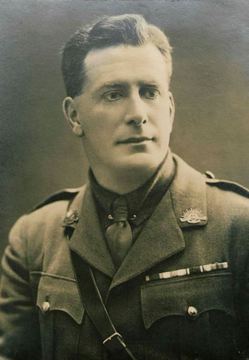SANDERSON, Alexander
| Service Number: | Officer |
|---|---|
| Enlisted: | 1 February 1916 |
| Last Rank: | Captain |
| Last Unit: | 3rd Tunnelling Company (inc. 6th Tunnelling Company) |
| Born: | Oamaru, New Zealand, 3 December 1881 |
| Home Town: | Claremont, Western Australia |
| Schooling: | Not yet discovered |
| Occupation: | Civil and Mining Engineer and Surveyor |
| Died: | Beckenham, Kent England, 9 August 1971, aged 89 years, cause of death not yet discovered |
| Cemetery: | Not yet discovered |
| Memorials: | Midland Officers & Contract Surveyors of the Department of Lands & Surveys WA Honour Roll |
World War 1 Service
| 1 Feb 1916: | Enlisted AIF WW1, Lieutenant, Officer, Mining Corps | |
|---|---|---|
| 16 Feb 1916: | Promoted AIF WW1, Captain | |
| 20 Feb 1916: | Involvement Captain, Mining Corps, --- :embarkation_roll: roll_number: '6' embarkation_place: Sydney embarkation_ship: HMAT Ulysses embarkation_ship_number: A38 public_note: '' | |
| 20 Feb 1916: |
Embarked
AIF WW1, Captain, Officer, Mining Corps, Embarked on HMAT 'A38' Ulysses from Sydney on 20th February 1916. Voyage sailed via Melbourne, Victoria, and Fremantle, Western Australia where additional members of the Corps were embarked. After a delay of about a month due to Ulysses requiring repairs following a collision with an uncharted rock when leaving Fremantle. The men on board nicknamed her ‘Useless’. Captain Alex Sanderson personally supervised the filling of the gash in the ship with concrete (he was later a pioneer of reinforced concrete) so it could sail to Europe. On arrival in Egypt the Captain of the HMAT 'A38' Ulysses was reluctant to take her out of the Suez Canal because he felt the weight of the ship made it impossible to manoeuvre in the situation of a submarine attack. The troops were transhipped to HM Transport B.1 Ansonia, which docked at Marseilles, France on 5th May 1916, where the Corps disembarked. As a unit they entrained at Marseilles on 7th May 1916 and detrained on 11th May 1916 at Hazebrouk. |
|
| 30 Jul 1916: | Transferred AIF WW1, Captain, 3rd Tunnelling Company (inc. 6th Tunnelling Company) | |
| 26 Sep 1916: |
Honoured
Military Cross, Captain Alexander SANDERSON 'No. 3 Mining Coy., Australian Engineers. 'Near PICANTIN on the night of the 18/19th July 1916, he worked under heavy shell fire in a forward sap, which gave little or no cover in pushing and exploding loaded pipes to form a communication trench. The leads for exploding were several times cut by shell fire, and it was therefore necessary to go out in the front of the trenches to light the fuse. The first attempt was stopped by shell fire which caused six casualties including the O.C. the Company. He succeeded however in a second attempt to fire the charge, which was entirely successful. He showed great pluck and determination throughout.' |
|
| 17 Sep 1917: |
Honoured
Military Cross and bar, Capt. Alexander SANDERSON, MC., 2nd Tunnelling Coy., Aust. Engrs. 'During a raid carried out against enemy trench east of LOOS by two Infantry Battalions on the evening of the 28th June 1917, Capt. SANDERSON entered the enemy trench with some men of his Coy. This Officer did excellent work reconnoitring the enemy's mining system behind the point of entry, and cutting the leads. The party successfully destroyed three enemy mine shafts and blew in two dug outs.' |
|
| 31 Dec 1918: | Honoured Mention in Dispatches | |
| 1 Jan 1919: |
Honoured
Companion of the Distinguished Service Order, Major Alexander SANDERSON MC 'This officer has done consistent good work in mine fighting and subway construction under trying conditions during the past two years on the Loos - Hill 70 front. He has commanded the 3rd Australian Tunnelling Company since 1.7.17 with exceptional ability and has always inspired his officers and men by his gallantry and coolness when under heavy shell fire.' Awarded M.C. 1916 (immediate award) Awarded Bar to M.C. 1917 (immediate award) H.H/ Yuill Lt. Col. Controller of Mines First Army |
Help us honour Alexander Sanderson's service by contributing information, stories, and images so that they can be preserved for future generations.
Add my storyBiography contributed by Daryl Jones
Major Alexander Sanderson served as Commanding Officer of the 3rd Australian Tunnelling Company during WWI, after which he relocated to England. Through WWII, he oversaw damage repairs to London transport. During this time he submitted proposals to the Minister of Aircraft Production for the design of VTOL tilt-engine aircraft. Although the designs were not successful, they illustrate the dynamics of scientific developments during wartime, when unconventional ideas and establishing a technological advantage over enemies were seen as essential elements in winning the war.
Source : Science Museum Group - United Kingdom











